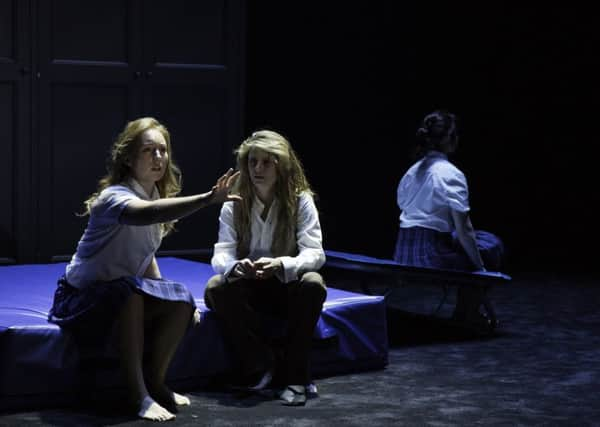Theatre Review: Picnic at Hanging Rock


Picnic at Hanging Rock ****
Lyceum Theatre, Edinburgh
There’s never any sense, here, that the whole story of Joan Lindsay’s great 1967 novel will be “acted out”. Instead, in Tom Wright’s adaptation and Matthew Lutton’s production, we see five schoolgirls who exist both now, and in 1900, and at any time between, standing on a deep blue stage – almost bare, but strangely angled – retelling this great Australian myth, the story of three girls and a schoolmistress who disappear completely during a picnic at the ancient aboriginal site of Hanging Rock, on Valentine’s Day 1900.
Sometimes, they take on the characters of other figures in the story, and perform key scenes: Elizabeth Nabben plays a key role as the school’s increasingly distraught English headmistress Mrs Appleyard, whose stern life-long mission to “civilise” the young women of Australia falls apart after the disappearance, and Amber McMahon is disturbingly brilliant as Michael, the young Englishman who glimpses the girls at the rock, and becomes obsessed with their fate.
Advertisement
Hide AdIn the end, though, the theatrical impact of the show has less to do with conventional performance than with an electrifying combination of performance and narrative structure, as scenes suddenly fall into black holes of absence full of uncanny sound or dream-like images, and phrases from the novel appear illuminated above the stage, guiding us deep into the strangeness of the story.
Wright’s adaptation gives fierce attention to the novel’s sense of the sheer arrogance and inadequacy of imperial British culture, as it tried to “tame” a land so ancient, implacable, and strange. Yet it is brilliant, too, on the infinitely mutable energy of youth, the huge suppressed erotic power and pressure, in these young women, that feels as if it could literally move mountains, and tear its way through a gap in time. And like Lindsay’s novel, it also asks us to confront the strange, elastic quality of time itself; and the possible existence of the “many worlds” briefly glimpsed by Michael, when he returns to the rock to find one of the girls alive, but the others gone without trace.
*Until 28 January